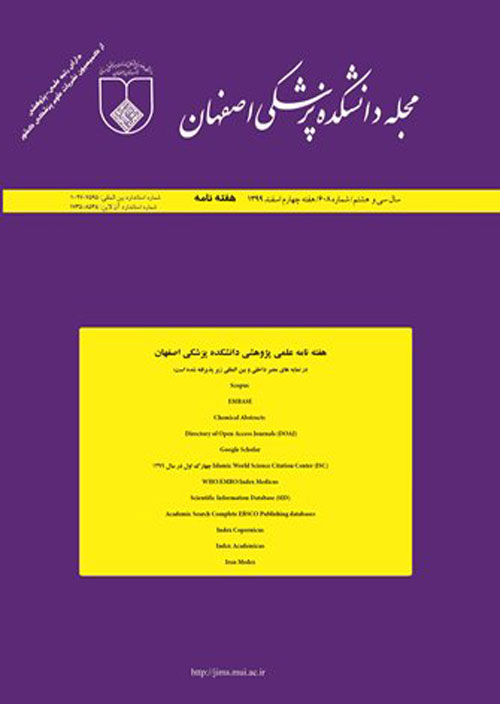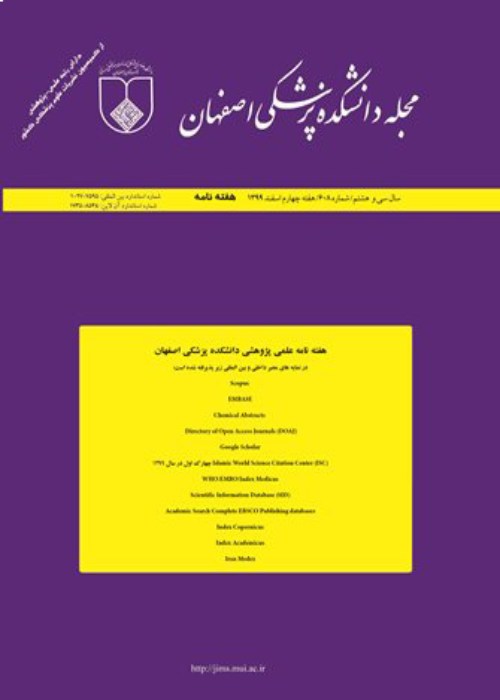فهرست مطالب

مجله دانشکده پزشکی اصفهان
پیاپی 623 (هفته سوم تیر 1400)
- تاریخ انتشار: 1400/04/15
- تعداد عناوین: 3
-
-
صفحات 303-309
مقدمه :
فوزالون، به عنوان یک آفت کش ارگانوفسفره جهت کنترل آفات مورد استفاده قرار می گیرد. استرس اکسیداتیو، یکی از مهم ترین مکانیسم هایی است که فوزالون از طریق آن باعث سمیت می شود. مطالعه ی حاضر، با هدف ارزیابی اثرات ژنوتوکسیک احتمالی به دنبال تماس با سم فوزالون در سلول های مغز قرمز استخوان موش سوری انجام شد.
روش هادر این مطالعه، از 60 سر موش سوری سالم نر بالغ (سن 8-6 هفته و وزن تقریبی بین 25-20 گرم) استفاده شد که به 6 گروه تقسیم شدند (10 = n در هر گروه). گروه 1، حامل سم فوزرالون به مدت 5 روز متوالی به صورت گاواژ (گروه شاهد منفی)، گروه 2، داروی سیکلوفسفامید با دز 40 میلی گرم/کیلوگرم به صورت داخل صفاقی (شاهد مثبت) و گروه های 3، 4، 5 و 6 فوزالون را در دزهای 40، 20، 12 و 6 میلی گرم/کیلوگرم وزن بدن در 5 روز متوالی به صورت گاواژ دریافت کردند. پس از جداسازی مغز استخوان و لنفوسیت ها از موش های سوری، آزمون Comet جهت ارزیابی اثرات ژنوتوکسیک به کار گرفته شد.
یافته هامیزان Tail length در گروه های دریافت کننده ی فوزالون به مدت 1 و 5 روز در دزهای 12، 20 و 40 میلی گرم/کیلوگرم با گروه شاهد منفی (حامل سم فوزالون) تفاوت معنی داری داشت (050/0 > P). همچنین، عامل زمان نیز در افزایش این تخریب موثر است؛ به گونه ای که در بررسی 5 روزه نسبت به 1 روزه تخریب DNA بیشتری مشاهده شد.
نتیجه گیریدر این مطالعه، اثرات ژنوتوکسیک وابسته به دز و زمان با سم فوزالون مشاهده شد. از این رو، پیشنهاد می گردد توجه جدی در محدودیت استفاده از این ترکیب به عنوان آفت کش در عرصه ی کشاورزی صورت پذیرد.
کلیدواژگان: ارگانوفسفره، فوزالون، آزمون Comet، سیکلوفسفامید، زولون -
صفحات 310-316
مقدمه :
فیبریلاسیون دهلیزی، آریتمی فوق بطنی و یکی از رایج ترین عوارض بعد از عمل جراحی بای پس عروق کرونر است. مطالعه ی حاضر با هدف تعیین ارتباط سطح سرمی منیزیم و وقوع فیبریلاسیون دهلیزی پس از عمل جراحی بای پس عروق کرونر در بیماران مراجعه کننده به بیمارستان بوعلی سینای قزوین انجام گردید.
روش هاطی این مطالعه ی مشاهده ای، 137 بیمار کاندیدای جراحی بای پس عروق کرونر وارد مطالعه شدند. اطلاعات دموگرافیک و سوابق بیماری برای بیماران ثبت گردید. بیماران به مدت سه روز تحت نظر بودند و روزانه سطح سرمی منیزیم آن ها ارزیابی شد. بیماران بر اساس وقوع یا عدم وقوع هایپومنیزیمی در روز عمل و روزهای اول تا سوم پس از عمل جراحی به دو گروه هیپومنیزیمی و نورمومنیزیمی تقسیم شدند. بیماران از نظر بروز آریتمی های قلبی پایش و در صورت نیاز، سولفات منیزیم تزریق و دز آن ثبت شد. در نهایت، داده های حاصل از مطالعه با استفاده از نرم افزار SPSS واکاوی شد.
یافته هااختلاف سطح سرمی منیزیم در روزهای قبل و روز جراحی و اول تا سوم پس از جراحی در تمامی فواصل مطالعه از نظر آماری میان دو گروه معنی دار بود. تفاوت میان دو گروه از نظر بروز فیبریلاسیون دهلیزی از لحاظ آماری معنی دار نبود (797/0 = P)؛ اما تفاوت آماری معنی داری میان دو گروه از نظر زمان بروز فیبریلاسیون دهلیزی دیده شد (014/0 = P).
نتیجه گیریهمچنان، نقش منیزیم در بروز فیبریلاسیون دهلیزی پس از جراحی بای پس عروق کرونر به طور دقیق مشخص نیست و در این زمینه، نیاز به مطالعات بیشتر می باشد.
کلیدواژگان: بایپس عروق کرونر، منیزیم، آریتمی -
صفحات 317-327
مقدمه :
در شرایط پاندمی کووید 19 و مخاطرات انتقال بیماری به سایر افراد در محیط بیمارستانی و در عین حال، لزوم انجام برخی جراحی ها، اجرای اقدامات پیشگیرانه در اتاق های عمل باید به طور جدی مد نظر قرار گیرد. پژوهش حاضر با هدف بررسی دستورالعمل های مهم جراحی در زمان همه گیری کرونا انجام شد.
روش هااین مطالعه از نوع مروری سیستماتیک بود. داده ها با استفاده از کلید واژه های «کرونا، کووید 19، اتاق عمل و جراحی» در پایگاه های اطلاعاتی PubMed، Scopus و Scientific information database (SID) و موتور جستجوگر Google Scholar جستجو و توسط دو نفر از نویسندگان جمع آوری گردید. معیارهای ورود مقالات شامل انتشار در سال های 2020 و 2021، پژوهش های اصیل، داشتن زبان لاتین و وجود کلید واژه ها در عنوان یا چکیده ی مقالات بود. با اعمال معیارهای ورود و خروج از بین 100 مقاله و سایت منتخب، 54 مورد انتخاب شد و پس از انجام بررسی دوم توسط پژوهشگر دیگر، در نهایت 29 مقاله مرتبط مورد بررسی و تجزیه و تحلیل قرار گرفت.
یافته هااز مهم ترین نکات در زمان همه گیری کووید 19 در فضای اتاق های عمل، می توان به «کاهش تعداد اعمال جراحی الکتیو، استفاده ی صحیح از وسایل حافظت شخصی توسط تیم جراحی در اتاق عمل، استفاده از پورت کوچک جهت جلوگیری از نشت گاز و فشار کم اینسوفلاسیون در اعمال جراحی لاپاراسکوپیک، استفاده از فیلتر مرطوب کننده ی یک بار مصرف در محیط اتاق عمل جهت تهویه ی بهتر هوا، استفاده از ایروی یک بار مصرف و لارنگوسکوپ ویدیویی در بیهوشی و افزایش دفعات تهویه بیش از 25 بار در ساعت بین جراحی ها» اشاره کرد.
نتیجه گیریلازم است دستورالعمل های ارایه شده، در اتاق عمل نصب شود و مسوولان اتاق عمل نظارت دقیقی بر حسن اجرای آن داشته باشند.
کلیدواژگان: کووید 11، اتاق عمل، جراحی
-
Pages 303-309Background
Phosalone is used as a pesticide to control pests. Oxidative stress is one of the most important mechanisms by which Phosalone causes toxicity. The aim of this study was to evaluate the possible genotoxic effects following exposure to Phosalone in red bone marrow cells of mice.
MethodsIn this study, 60 Syrian male mice [with 6 to 8 weeks of age and body weight (BW) of 20-25 g] were divided to 8 equal groups. Group 1 received Phosalone career by gavage for 5 days (negative control), group 2 received cyclophosphamide with the dose of 40 mg/kg by gavage for 5 days (positive control), and groups 3, 4, 5, and 6 received Phosalone at doses of 6, 12, 20, and 40 mg/kg BW for 5 consecutive days by gavage. After isolating bone marrow and lymphocytes from mice, comet test was performed to evaluate genotoxic effects 1 and 5 days following exposure to Phosalone.
FindingsTail length in the groups receiving Phosalone for 1 day and 5 days at doses of 12, 20, and 40 mg/kg BW was significantly different from the negative control group (P < 0.050). The time factor was also effective in increasing this degradation; as in 5-day assessment more DNA degradation was observed than 1-day assessment.
ConclusionIn this study, dose- and time-dependent genotoxic effects with Phosalone were observed. It also highlights the need for serious attention to limiting the use of this compound as a pesticide in agriculture.
Keywords: Organophosphates, Phosalone, Comet assay, Cyclophosphamide, Zolone -
Pages 310-316Background
Atrial fibrillation is a supraventricular arrhythmia, and is one of the most common complication after coronary artery bypass graft surgery (CABG). The aim of this study was to determine the relationship between serum magnesium level and the occurrence of atrial fibrillation after CABG in patients referred to Bu-Ali Sina hospital in Qazvin, Iran.
Methods137 patients who were candidates for CABG surgery were included in this observational study. Demographic information and medical records were recorded for patients. Patients were monitored for three days, and their serum magnesium levels were assessed daily. Patients were divided into hypomagnesium and normomagnesium groups based on the presence or absence of hypomagnesemia in the surgery day and the first to third day after surgery. Patients were monitored for cardiac arrhythmias, and if necessary, magnesium sulfate injection and its dose were recorded. Finally, the data obtained from the study were analyzed using SPSS software.
FindingsSerum magnesium level was significantly different between the two groups before and on the day of surgery, and one to three days after surgery at all study intervals. The difference between the two groups in terms of atrial fibrillation incidence was not statistically significant (P = 0.797); but there was a statistically significant difference between the two groups in terms of atrial fibrillation incidence time (P = 0.014).
DiscussionThe role of magnesium in incidence of atrial fibrillation after CABG surgery is still unclear, and further studies are needed.
Keywords: : Coronary artery bypass, Magnesium, Arrhythmia -
Pages 317-327Background
In the case of COVID-19 pandemic and the risks of transmitting the disease to other people in the hospital environment, and the need to performing some surgeries, implementing preventive measures in operating rooms should be seriously considered. The aim of this study was to investigate the important surgical instructions during COVID-19 pandemic.
MethodsThis was a systematic review study in which data were collected by searching PubMed, Scopus, and Scientific Information Database (SID) databases and Google Scholar search engine with the keywords Corona, COVID 19, operating room, and surgery. Inclusion criteria of articles included published in 2020 and 2021, original articles, English language, and having the keywords in the title or abstract. By applying inclusion and exclusion criteria, out of 100 articles and selected sites, 54 articles were selected, and after the second review by another researcher, 29 articles completely related to the subject were reviewed and analyzed.
FindingsSome of the most important points during the COVID-19 pandemic in the operating room space is to reduce the number of elective surgeries, correct use of personal protective equipment by the surgical team in the operating room, use of a small port to prevent gas leakage and low insufflation pressure in laparoscopic surgery, use of disposable moisturizing filter in the operating room environment for better ventilation, use of disposable airway and video laryngoscope by anesthesiologist, and increasing the frequency of ventilation more than 25 times per hour between surgeries.
ConclusionIt is necessary to install provided instructions in the operating room, and the operating room supervisors have close monitor over its proper implementation.
Keywords: COVID-19, Operating room, Surger


